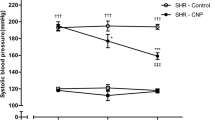Summary
Recent studies have shown that angiotensin converting enzyme (ACE) inhibitor treatment in young spontaneously hypertensive rats (SHR) reduces blood pressure into adulthood. This study explored changes in vascular reactivity in adult normotensive (WKY) rats and stroke-prone SHR (SHRSP) receiving the following treatments at 6–10 weeks of age: (a) ACE inhibitor (ramipril); (b) hydralazine/hydrochlorothiazide (hydral/HCTZ); or (c) no treatment. The hypothesis tested was that vascular changes and blood pressure would be reduced in adult SHRSP treated with ramipril during development. At 17 weeks of age, rats were anesthetized and vascular tissue was excised. Isolated experiments in the aorta included characterization of initial phasic and tonic contractions to 0.1 µM angiotensin II (AII). A phenylephrine (PE) concentration-response curve was performed on carotid arteries, and threshold values were determined. All WKY groups showed lower systolic blood pressure (131±4 mmHg) and reduced phasic AII induced contraction (7.4±4.7%) compared with SHRSP (217±4 mmHg; 37.2±4%). Antihypertensive treatment reduced blood pressure (ramipril: 168±2; hydral/HCTZ: 198±6 mmHg) but not phasic AII responses in adult SHRSP; adult WKY rats were unaffected by treatment. Threshold values for PE in carotid arteries were lower in SHRSP than in WKY, indicating increased sensitivity. However, SHRSP treated with ramipril did not demonstrate increased sensitivity to PE. These data support the hypothesis that blood pressure and sensitivity to PE but not contractile responsiveness to AII in adult SHRSP are determined by an AII-sensitive mechanism during development.
Similar content being viewed by others
References
Harrap SB. Causes and effects of high blood pressure: A longitudinal approach to genetic cosegregational analysis.J Cardiovasc Pharmacol 1988;12(Suppl 3):S99-S109.
Soubrier F, Houot AM, Jeunemaitre X, Plouin PF, Corvol P. Molecular biology as a tool for genetic research in hypertension: Application to the renin gene.J Cardiovasc Pharmacol 1988;12(Suppl 3):S155-S159.
Mulvany MJ, Korsgaard N. Correlations and otherwise between blood pressure, cardiac mass and resistance vessel characteristics in hypertensive, normotensive and hypertensive/normotensive hybrid rats.J Hypertens 1983;1:235–244.
Laher I, Triggle C. Blood pressure, lanthanum-, and norepinephrine-induced mechanical response in thoracic aortic tissue.Hypertension 1984;6:700–708.
Rapp JP. A genetic locus (Hyp-2) controlling vascular smooth muscle response in spontaneously hypertensive rats.Hypertension 1982;4:459–467.
Harrap SB, Van der Merwe WM, Griffin SA, Macpherson F, Lever AF. Brief angiotensin converting enzyme inhibitor treatment in young spontaneously hypertensive rats reduces blood pressure long term.Hypertension 1990;16:603–616.
Lee RM, Berecek KH, Tsoporis J, McKenzie R, Triggle CR. Prevention of hypertension and vascular changes by captopril treatment.Hypertension 1991;17:141–150.
Harrap SB. A developmental genetic mechanism involving angiotensin in spontaneously hypertensive rats.Clin Exp Pharmacol Physiol Suppl 1992;19:19–22.
Morton JJ, Beattie EC, MacPherson F. Angiotensin II receptor antagonist losartan has persistent effects on blood pressure in the young spontaneously hypertensive rat: Lack of relation to vascular structure.J Vasc Res 1992;29:264–269.
Giudicelli JF, Freslon JL, Glasson S, Richer C. Captopril and hypertension development in the SHR.Clin Exp Hypertens 1980;2:1083–1096.
Sessler FM, Kim SH, Malvin RL. Changes of renin isoelectric heterogeneity after acute and chronic stimulation of renin secretion.Proc Soc Exp Biol Med 1986;182:258–262.
Kojima M, Aoki K, Fujimoto S, Matsoda T. Malfunction of arterial sarcoplasmic reticulum leading to faster and greater contraction induced by high-potassium depolarization in young spontaneously hypertensive rats.J Hypertens 1991;9:783–788.
Urabe M, Su, Lee TJ. Pre- and postsynaptic effects of angiotensins in the femoral artery of spontaneously hypertensive and Wistar-Kyoto rats.Blood Vessels 1987;24:1–10.
Couture R, Regoli D. Vascular reactivity to angiotensin and noradrenaline in spontaneously and renal hypertensive rats.Clin Exp Hypertens 1980;2:45–63.
Li P, Jackson EK. Enhanced slow-pressor response to angiotensin II in spontaneously hypertensive rats.J Pharmacol Exp Ther 1989;251:909–921.
Bendhack LM, Sharma RV, Bhalla RC. Altered signal transduction in vascular smooth muscle cells of spontaneously hypertensive rats.Hypertension 1992;19(Suppl):II142-II148.
Wilson KM, Magargal W, Berecek KH. Long-term captopril treatment. Angiotensin II receptors and responses.Hypertension 1988;11:I148-I152.
Owens GK. Role of contractile agonists in growth regulation of vascular smooth muscle cells.Adv Exp Med Biol 1991;308:71–79.
Mackie EJ, Scott-Burden T, Hahn AW, et al. Expression of tenascin by vascular smooth muscle cells. Alterations in hypertensive rats and stimulation by angiotensin II.Am J Pathol 1992;141:377–388.
Paul M, Ganten D. The molecular basis of cardiovascular hypertrophy: The role of the renin-angiotensin system.J Cardiovasc Pharmacol 1992;19(Suppl 5):S51-S58.
Bohr DF, Uchida E. Individualities of vascular smooth muscles in response to angiotensin.Circ Res 1967;21(Suppl 2):135.
Draper AJ, Meghji S, Redfern PH. Enhanced presynaptic facilitation of vascular adrenergic neurotransmission in spontaneously hypertensive rats.J Auton Pharmacol 1989;9:103–111.
Harrap SB, Mitchell GA, Casley DJ, Mirakian C, Doyle AE. Angiotensin II, sodium, and cardiovascular hypertrophy in spontaneously hypertensive rats.Hypertension 1993;21:50–55.
Sada T, Koike H, Miyamoto M. Long-term inhibition of angiotensin converting enzyme suppresses calcium channel agonist-induced contraction of aorta in hypertensive rats.Hypertension 1989;14:652–659.
Tofovic SP, Branch KR, Oliver RD, Magee WD, Jackson EK. Caffeine potentiates vasodilator-induced renin release.J Pharmacol Exp Ther 1991;256:850–860.
Luft FC, Fineberg NS, Weinberger MH. Long-term effect of nifedipine and hydrochlorothiazide on blood pressure and sodium homeostasis at varying levels of salt intake in mildly hypertensive patients.Am J Hypertens 1991;4:752–760.
Author information
Authors and Affiliations
Rights and permissions
About this article
Cite this article
Traub, O., Lloyd, M.C. & Webb, R.C. Long-term effects of brief antihypertensive treatment on systolic blood pressure and vascular reactivity in young genetically hypertensive rats. Cardiovasc Drug Ther 9, 421–429 (1995). https://doi.org/10.1007/BF00879031
Received:
Accepted:
Issue Date:
DOI: https://doi.org/10.1007/BF00879031




